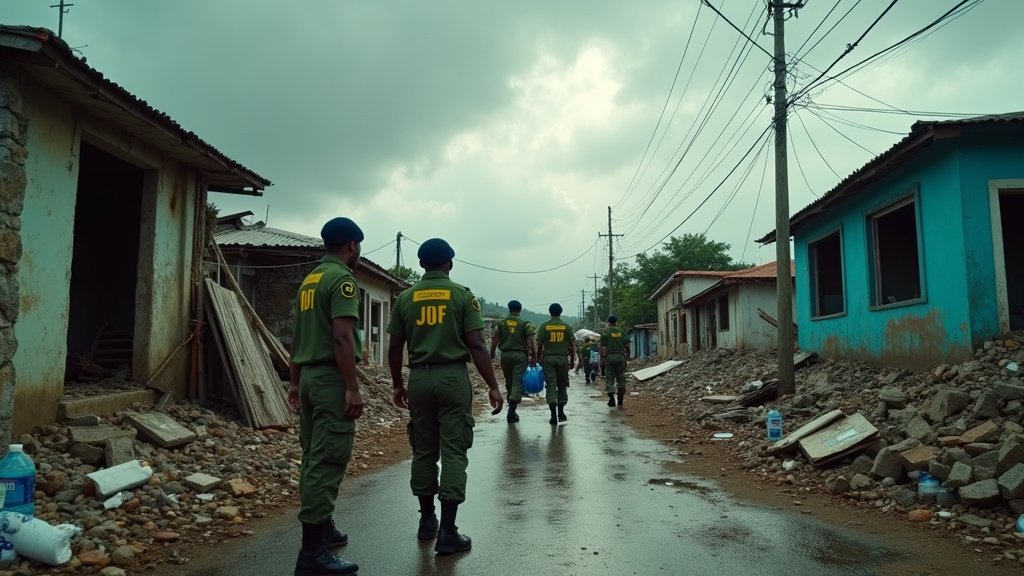KINGSTON, JAMAICA – In the wake of Hurricane Melissa, the strongest hurricane to ever hit the island, relief efforts are in full swing across Jamaica, as the nation confronts unprecedented destruction and a mounting humanitarian crisis following the devastating landfall of Hurricane Melissa Jamaica. The storm has left a trail of destruction, claiming lives, obliterating homes, and crippling essential infrastructure, prompting a massive mobilization of national and international aid following the Hurricane Melissa Jamaica event.
The Unrelenting Fury of Hurricane Melissa Jamaica
Hurricane Melissa struck Jamaica on October 28, 2025, with sustained winds of 185 mph, unleashing catastrophic winds, torrential rainfall, and a destructive storm surge that submerged coastal communities. The sheer force of this Hurricane Melissa Jamaica has been described as unlike anything previously witnessed on the island. The immediate aftermath revealed widespread flooding, significant landslides, and extensive damage to buildings, including entire roofs torn from homes and critical infrastructure rendered inoperable. In many areas, particularly in western and southern Jamaica, the landscape was transformed into a scene of rubble and debris, with once-vibrant towns reduced to mud pits and impassable obstacle courses. The Jamaica hurricane aftermath is extensive.
Human Toll and Isolated Communities After Hurricane Melissa Jamaica
The human cost of Hurricane Melissa has been profound. Authorities have reported at least 19 confirmed deaths in Jamaica, with the total regional toll exceeding 50. Thousands of residents have been displaced, many rendered homeless as their dwellings were destroyed or severely damaged. Access to many communities has been severely hampered by the destruction of roads and bridges, leaving survivors isolated and cut off from vital supplies for days. More than 460,000 people, approximately 66% of the customer base, lost power island-wide, and communication networks remain largely down, further complicating rescue and assessment efforts. Nearly 400 water systems were also knocked out by the storm, exacerbating the urgent need for clean drinking water and contributing to a potential Jamaica humanitarian crisis. The Hurricane Melissa storm surge damage is severe.
National and International Relief Mobilization for Hurricane Melissa Jamaica
In response to the crisis, the Jamaican government has declared a national disaster and activated its National Emergency Operations Centre, coordinating efforts with the Office of Disaster Preparedness and Emergency Management (ODPEM) and other agencies. Prime Minister Andrew Holness declared Black River, a coastal town in St. Elizabeth, as “ground zero” for the Hurricane Melissa impact, underscoring the extent of devastation. The Jamaica Defense Force (JDF) has been at the forefront of relief operations, establishing satellite disaster relief sites to dispatch care packages and mobilizing members of the Jamaica National Reserve to support search and rescue, logistics, and security efforts following the natural disaster Jamaica faced during Hurricane Melissa Jamaica.
International support has rapidly poured in. The U.S. Army deployed CH-47 Chinook and other helicopters to deliver humanitarian aid, while Joint Task Force-Bravo began a deployment to Kingston. The World Food Programme (WFP) is working closely with the Jamaican government to coordinate logistics and distribute emergency food assistance, including shipments from Barbados. The Jamaica Red Cross has mobilized 400 volunteers, distributing essential supplies like blankets, hygiene kits, and tarpaulins. Organizations such as Project HOPE are on the ground providing critical health, water, sanitation, and hygiene (WASH) support, including medical supplies for damaged health facilities. Amazon has also offered technological advisory services to aid in restoring power and connectivity, while positioning supplies from its disaster relief hubs. These Jamaica disaster relief efforts are crucial for Jamaica’s recovery from Hurricane Melissa Jamaica.
Rebuilding and Resilience After Hurricane Melissa Jamaica
Beyond immediate relief, the long-term implications of Hurricane Melissa are stark. Preliminary damage assessments indicate unprecedented Hurricane Melissa destruction of infrastructure, with economic losses projected to reach single-digit billions of U.S. dollars. The Caribbean Catastrophe Risk Insurance Facility announced a record payout of $70.8 million to Jamaica, which, alongside government contingency funds and a catastrophe bond, forms part of the financial strategy for recovery from this Jamaica hurricane. The UK government pledged significant humanitarian funding, while Canada committed $7 million for emergency relief efforts. Governments and aid agencies emphasize that cash donations to trusted charities are the most effective way to support recovery, allowing for the rapid purchase of locally needed supplies following Hurricane Melissa Jamaica.
The path to recovery for Jamaica will be arduous, marked by immense challenges in rebuilding infrastructure, restoring essential services, and supporting communities still reeling from the storm’s ferocity. This news underscores the critical need for sustained support and investment in disaster preparedness and resilience for nations frequently impacted by extreme weather events. Even as the nation grapples with the physical and economic devastation, the spirit of resilience among the Jamaican people remains a vital force in the face of this catastrophe. The unfolding news from the island paints a picture of a community united in its determination to rebuild stronger and wiser after Hurricane Melissa Jamaica.

